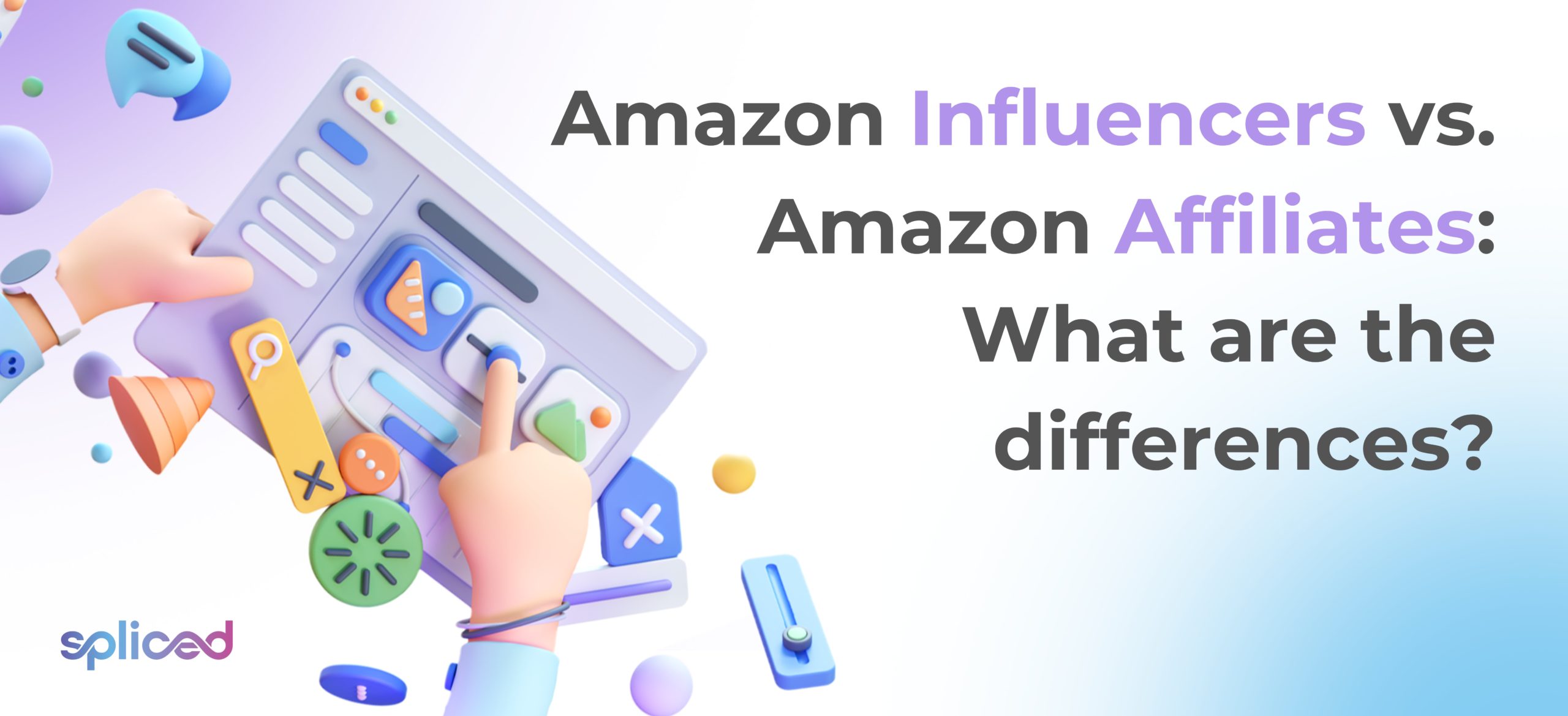Amazon Influencers and Amazon Affiliates provide individuals with unique chances to interact with Amazon and earn money through their online activities. Amazon Influencers are content creators of Amazon noted for their social media expertise and ability to engage on a personal level with their audience. These people have established themselves as influencers in a variety of fields, by their knowledge, enthusiasm, or lifestyle. Amazon Influencers give product suggestions, reviews, and personal experiences to their followers, instilling confidence in their followers to make informed purchasing decisions. Their goal is to establish trust and engagement with their audience, and they use their distinct personalities to connect with and influence their followers.
Amazon Affiliates are internet marketers who specialize in boosting sales and conversions. Amazon Affiliates conduct their business through websites, blogs, and other digital media. They produce material with the intention of increasing online traffic and directing it to Amazon product sites. Amazon Affiliates are niche experts who position themselves as authorities in specific product categories and focus on making royalties based on sales. Their goal is to facilitate product discovery and generate sales through strategic content production and marketing methods.
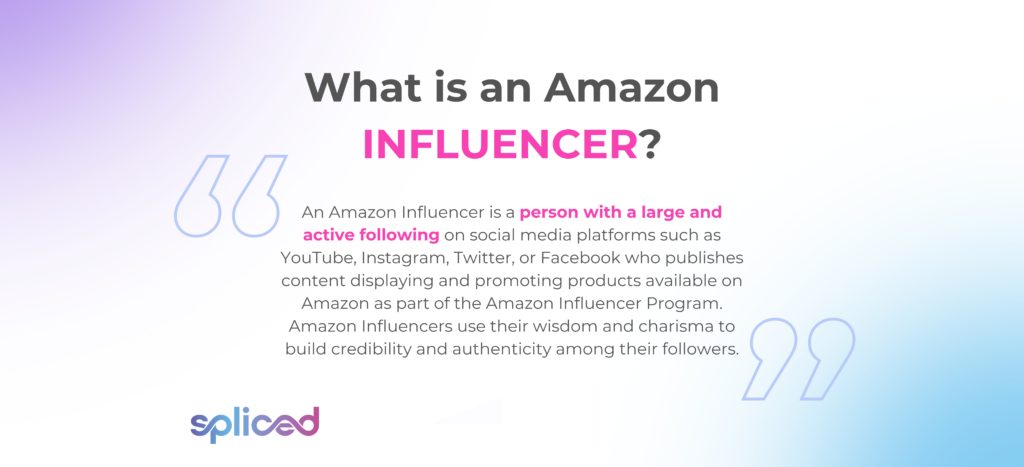
What is an Amazon Influencer?
An Amazon Influencer is a person with a large and active following on social media platforms such as YouTube, Instagram, Twitter, or Facebook who publishes content displaying and promoting products available on Amazon as part of the Amazon Influencer Program. Amazon Influencers use their wisdom and charisma to build credibility and authenticity among their followers. They compile lists of Amazon products that correspond to the interests of their niche or target audience, and these lists are accessible via their individual Amazon Influencer stores. These stores act as personalized hubs where followers easily search and buy the things they have been recommended. Each sale generated by their storefront connections earns the influencers a commission.
Amazon Influencers concentrate on specialty sectors ranging from elegance and fashion to technology, home improvement, or any other Amazon category. The data given is intended to be appealing, educational, and compelling, with the primary purpose of directing the audience to Amazon to research and buy goods.
A content creator with a sizable social media following who advises and promotes Amazon products in their niche in exchange for commissions from sales made through their own Amazon Influencer storefronts is known as an Amazon Influencer. The program is unique from the Amazon Affiliate Program, which is aimed at media businesses and brands rather than individual content creators.
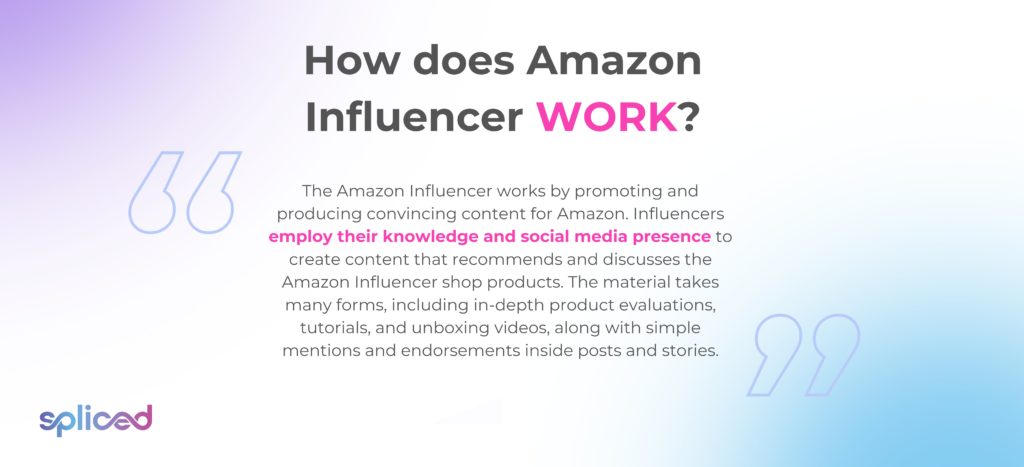
How does Amazon Influencer work?
The Amazon Influencer works by promoting and producing convincing content for Amazon. Influencers employ their knowledge and social media presence to create content that recommends and discusses the Amazon Influencer shop products. The material takes many forms, including in-depth product evaluations, tutorials, and unboxing videos, along with simple mentions and endorsements inside posts and stories.
Amazon Influencers begin a process of product evaluation and selection as soon as they receive access. Amazon Influencers have the freedom to choose from the vast array of products accessible on Amazon, hand-picking items that meet their niche or coincide with the preferences of their target audience. These products are then added to the influencer’s Amazon Influencer store and arranged into lists for easier navigation and accessibility.
Amazon Influencers prominently show their individual vanity URL in the descriptions or captions of their social media posts to connect their followers with the suggested products. The URL sends their audience to their personalized Amazon store, making it effortless for followers to search and buy the suggested products. The influencer gains a commission on each sale made through these storefront connections, monetizing their content and suggestions.
Amazon provides tools and statistics to influencers to monitor and evaluate the accomplishment of their business. The statistics monitoring involves measuring earnings, examining the popularity of specific products within their target audience, and obtaining data to help them enhance their strategy and product selection.
Establishing reliability and trust with followers is the core principle of the Amazon Influencer Program. Successful influencers retain their credibility by making honest and meaningful recommendations, regularly responding to their audience’s queries and feedback, and building long-term and true relationships with their followers. The program leverages the influencer’s reach and experience to bridge the gap between their audience and Amazon’s enormous product choices, resulting in a win-win situation for the influencer and Amazon.

What is the purpose of Amazon Influencer?
The purpose of Amazon Influencer is to capitalize on the considerable reach and influence that social media influencers and content creators have built up. Influencers have the capability to connect with and engage their target audiences, within certain niches or fields of expertise. Amazon realizes that it has the ability to utilize its existing clout to successfully advertise the huge array of products accessible on its platform.
One of the program’s primary goals is to provide individualized product suggestions to potential clients. Amazon Influencers produce product lists that are appropriate to their industry or of particular interest to their audience. These prepared lists are accessible via the influencer’s personalized Amazon Influencer storefront, allowing followers to shop in a convenient and targeted manner. The program attempts to increase the relevancy of Amazon’s product offers and improve the entire shopping experience by providing recommendations that resonate with their audience.
The program’s goal is dependent on trust and genuineness. Followers are more likely to believe advice from influencers they follow and appreciate. Amazon tries to utilize the authority and authenticity that these individuals have cultivated inside their particular sectors by working with influencers. The trust element makes potential customers more inclined to act on Amazon Influencer suggestions, ultimately generating sales and revenue for the e-commerce site.
The ability to monetize content creators’ online presence is another main objective of the Amazon Influencer Program. Influencers are compensated for sales generated by their customized Amazon stores. The sales give influencers an additional cash stream, letting them leverage their passion and experience into a source of income. Amazon encourages influencers to continue developing content and engaging with their audiences.
The program helps Amazon’s larger goal of growing its market reach and consumer base. Amazon is capable of reaching new and highly engaged audiences that have not explored the platform otherwise by working with influencers. The increase in reach and customer acquisition is necessary for Amazon’s competitiveness in the e-commerce market.
The initiative provides influencers with data and analytics tools. The technologies let them track the effectiveness of their Amazon Influencer shops, allowing them to learn which goods resonate the best with their audience and which advertising techniques are most effective. The data-driven strategy helps influencers improve their content and suggestions, which benefits the influencer and Amazon.
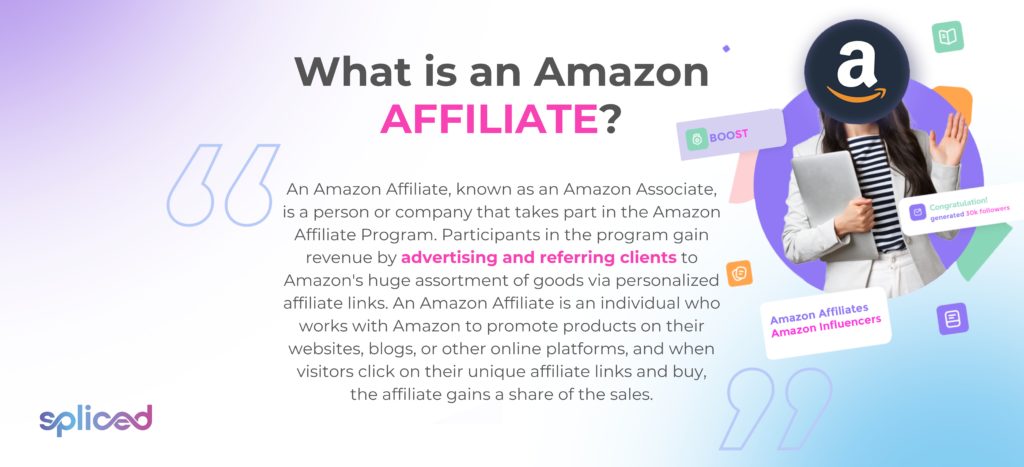
What is an Amazon Affiliate?
An Amazon Affiliate, known as an Amazon Associate, is a person or company that takes part in the Amazon Affiliate Program. Participants in the program gain revenue by advertising and referring clients to Amazon’s huge assortment of goods via personalized affiliate links. An Amazon Affiliate is an individual who works with Amazon to promote products on their websites, blogs, or other online platforms, and when visitors click on their unique affiliate links and buy, the affiliate gains a share of the sales.
Amazon Affiliates produce content and marketing materials to drive visitors to Amazon’s e-commerce marketplace. Product reviews, blog articles, social media posts, videos, and even entire websites dedicated to distinct product niches are all options for creating the material. Each piece of content has unique affiliate links that are capable of being tracked back to the affiliate, allowing Amazon to credit the affiliate for any sales generated by the referred traffic.
The program is appealing to content creators, bloggers, website owners, and digital marketers interested in monetizing their online presence. Amazon offers Affiliates a variety of tools and resources to assist them in effectively promoting products, such as banners, widgets, and even entire storefronts filled with Amazon products that are incorporated into their websites.
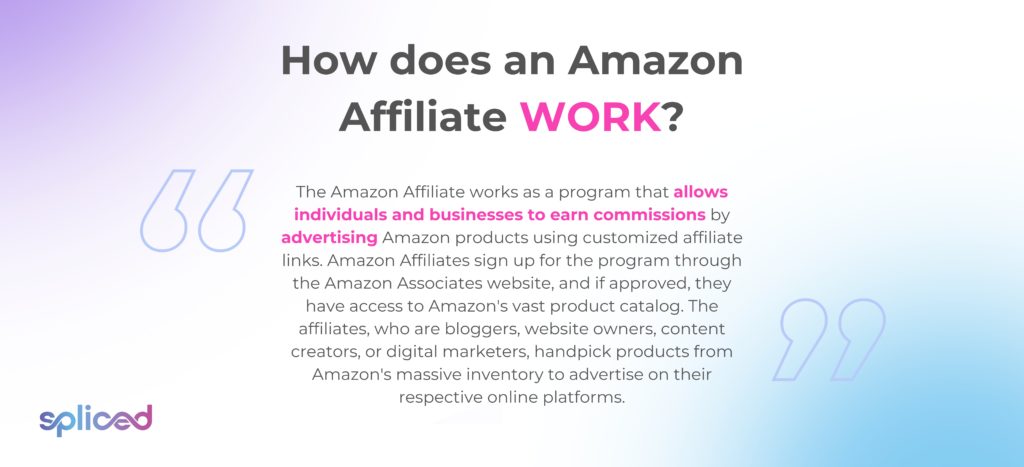
How does an Amazon Affiliate work?
The Amazon Affiliate works as a program that allows individuals and businesses to earn commissions by advertising Amazon products using customized affiliate links. Amazon Affiliates sign up for the program through the Amazon Associates website, and if approved, they have access to Amazon’s vast product catalog. The affiliates, who are bloggers, website owners, content creators, or digital marketers, handpick products from Amazon’s massive inventory to advertise on their respective online platforms.
A central aspect of the program is the use of customized affiliate links. Amazon assigns tracking IDs or tagged URLs to each affiliate. The personalized links allow Amazon to distinguish certain affiliate sales and behaviors. Amazon recognizes the recommendation and pays the relevant affiliate a commission when a customer clicks on one of these personalized links and completes a transaction from the affiliate’s website or social media page.
The Amazon Affiliate Program is built on content production. Amazon Affiliates create content that showcases and recommends Amazon products. Product reviews, educational blog articles, engaging social media postings, videos, and other forms of content are examples. Amazon Affiliates deliberately incorporate their unique affiliate links into their content to bring readers or viewers to Amazon product pages. The goal is to incorporate product suggestions into their content while maintaining relevance and appeal to their target audience.
The next step is to promote and distribute the content. Amazon Affiliates actively share and promote their material on the web channels of their choice. Promoting materials includes posting blog posts on social media, optimizing content for search engines, executing targeted advertising campaigns, or utilizing a variety of digital marketing methods. The ultimate goal is to deliver relevant and engaged visitors to Amazon’s product pages via the affiliate’s unique links.
Earning commissions is at the center of the program. An Amazon affiliate is entitled to a commission, which is a portion of the sale price when a visitor clicks on their unique link and then purchases something on Amazon. Commissions are made on consumer actions other than product purchases, such as signing up for Amazon’s free trial programs or other Amazon services, which expands the monetization even further.
Amazon pays affiliates monthly if they have met the program’s minimum payout level. Payment methods include direct transfers, Amazon gift cards, or checks, depending on the affiliate’s preference.
Amazon gives tracking and analytics tools to affiliates to help them with their promotional activities. Affiliates have the option to use the tools to track the performance of their affiliate links and evaluate the effectiveness of their promotional activities. The data-driven strategy allows affiliates to tweak their methods and improve their content to increase conversions and maximize earnings.
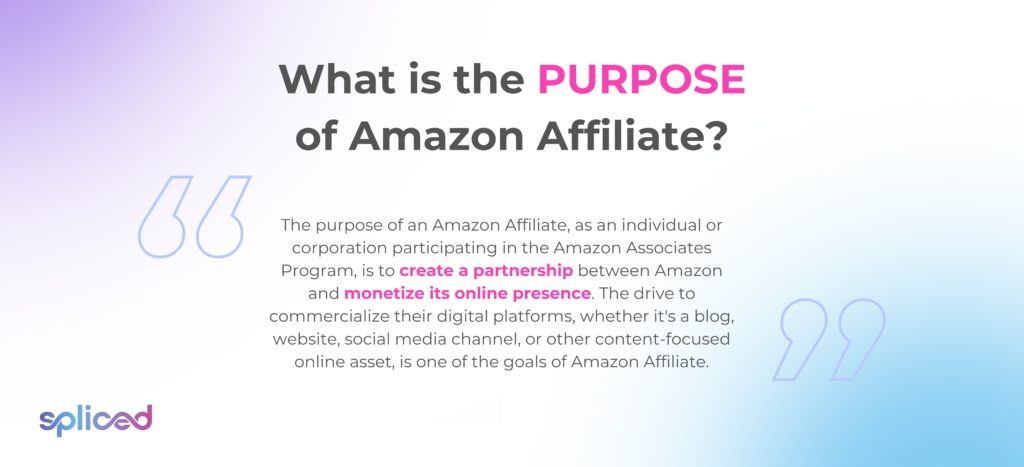
What is the purpose of Amazon Affiliate?
The purpose of an Amazon Affiliate, as an individual or corporation participating in the Amazon Associates Program, is to create a partnership between Amazon and monetize its online presence.
The drive to commercialize their digital platforms, whether it’s a blog, website, social media channel, or other content-focused online asset, is one of the goals of Amazon Affiliate. Amazon Affiliates desire to produce money from their content development and audience engagement. They do it by collecting commissions on sales and consumer actions created by their promotional efforts. It creates an opportunity for bloggers, content creators, and website owners to turn their passion and skill into a measurable source of cash, allowing them to make their online presence more financially viable.
Amazon Affiliates connects Amazon’s large product catalog with customers. Amazon Affiliates’ mission is to propose and promote Amazon products that are applicable to their audience’s interests. The tailored method guarantees that the product recommendations are useful and relevant to their followers. Amazon Affiliates strive to improve their audience’s purchasing experience by providing personalized, niche-specific product recommendations. The goal emphasizes the importance of their job as a link between consumers and Amazon’s product offers.
Amazon Affiliates actively engage in content development to properly serve their objective. Amazon Affiliates make and distribute material that promotes the Amazon products they want to promote. Product reviews, blog articles, social media posts, videos, and other forms of content are examples. Affiliates include affiliate links within their content that direct their viewers to Amazon product pages. Affiliates effortlessly route their audience from their content to the Amazon platform, where sales are made, by strategically including affiliate links.
Trust and credibility have been part of the purpose of an Amazon Affiliate. Affiliates have built trust with their target audience. Their followers perceive them as authorities or experts in their particular fields. It carries a lot of weight when an affiliate offers a product recommendation. Their audience is more inclined to act on these recommendations since they trust the affiliate’s support.
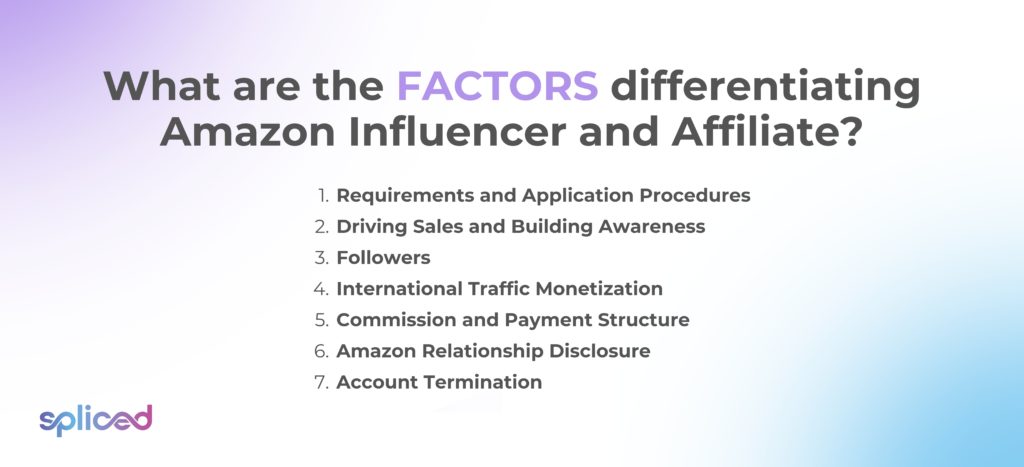
What are the factors differentiating Amazon Influencer and Affiliate?
The factors differentiating Amazon Influencer from Affiliate are listed below.
- Requirements and Application Procedures: Applicants for Amazon Influencer positions often have a strong social media presence and a large number of engaged followers on sites such as Instagram, YouTube, Twitter, or Facebook. Amazon Influencers apply directly through Amazon’s Influencer Program and it is subject to verification before being accepted into the program. The prerequisites for becoming an Amazon Affiliate are becoming more accessible. The Amazon Associates Program is open to almost anyone who has a digital presence, such as a website or blog. The application process is pretty simple, and acceptance is not overly strict.
- Driving Sales and Building Awareness: Amazon Influencers work to increase brand recognition and trust among their following. Amazon Influencers develop content and recommendations that inspire and engage their audience, without a major emphasis on generating direct purchases. The idea is to direct followers to their customized Amazon store. Amazon Affiliates are primarily concerned with increasing sales. Amazon Affiliates want to direct traffic from their platforms to Amazon product pages to generate conversions and earn commissions on sales.
- Followers: Influencers have a sizable and highly active social media following. Their success is based on the level of involvement and trust they’ve developed with their followers. Affiliates have a strong online presence, but they are not completely dependent on social media followers. They draw visitors through websites, blogs, and other internet media. The focus is on website visitors and traffic specific to a certain niche.
- International Traffic Monetization: Amazon Influencers cater to a global audience, and their earnings are derived from sales produced through their customized Amazon store, which is accessible to Amazon customers worldwide. Affiliates target individual Amazon stores or the global Amazon Associates Program. Their revenues depend on the Amazon website from which their referrals buy, and not all affiliates cater to foreign traffic.
- Commission and Payment Structure: Amazon Influencers receive commissions on the things they promote, but the specific compensation structure is not the major focus. Amazon compensates them for their participation in the Influencer Program. Affiliates are paid commissions in a tiered manner based on the product category. The higher the commission rate they achieve, the more things they sell. Affiliates’ primary source of income is commissions.
- Amazon Relationship Disclosure: Amazon requires influencers to disclose their relationship with the company and their participation in the Influencer Program when they promote Amazon products. Transparency and trust are ensured by the disclosure. Affiliates declare their relationship with Amazon in addition to their participation in the Associates Program. Maintaining transparency and integrity requires ethical disclosure procedures.
- Account Termination: Amazon deletes an influencer’s account if they fail to follow program regulations, such as posting inappropriate content or failing to follow disclosure criteria. Termination results in the loss of access to the customized Amazon shop. Amazon cancels affiliate accounts for a variety of reasons, including violations of program standards, the generation of fraudulent clicks or purchases, or failure to meet the program’s operating agreement. Affiliates who are terminated lose access to their affiliate connections and commissions.
1. Requirements and Application Procedures
Requirements and application procedures refer to the criteria and processes that people must follow when applying for and participating in the Amazon Influencer Program and the Amazon Affiliate Program. The elements are needed for anyone wishing to partner with Amazon to promote its items.
Applicants must have a large presence on social media sites such as Instagram, YouTube, Twitter, or Facebook to become an Amazon Influencer. Applicants must have a large and engaged following, usually in the thousands or more. The application procedure is handled directly through Amazon’s Influencer Program, and potential influencers undergo screening to ensure they match the program’s requirements.
Amazon Influencers concentrate on developing a strong online persona and social media credibility. Amazon Influencers’ first purpose is to excite and engage their audience, with revenues coming in second. A fitness influencer with a large Instagram following, for example, encourages followers with workout suggestions before directing them to their Amazon Influencer storefront for recommended fitness products.
Amazon Affiliate standards are more approachable, allowing a broader spectrum of individuals to apply. The Amazon Associates Program is open to anyone who has a digital presence, such as a blog or website. The application process is simple and mainly consists of opening an Amazon Associates account.
Amazon Affiliates are primarily concerned with increasing sales. Amazon Affiliates’ goal is to lead people from various platforms to Amazon product sites, where they receive commissions on sales. A technology blogger, for example, posts evaluations of Amazon tech products on their blog and adds affiliate links that drive people to purchase such things on Amazon.
2. Driving Sales and Building Awareness
Driving sales and building awareness are primary objectives of marketing strategies used by Amazon Influencers and Amazon Affiliates. Amazon Influencers and Amazon Affiliates have different main goals, even though they both promote Amazon.
Amazon Influencers work hard to increase brand recognition and trust among their followers. Amazon Influencers’ main objective is to establish a true connection with their audience, without placing a great emphasis on generating immediate sales, yet they do encourage product purchases.
Amazon Influencers use their online following to inspire and engage their followers. A fashion influencer, for example, features Amazon apparel and accessories on their YouTube channel or Instagram, highlighting their style and utility while gaining the trust of their following. Sales are a result of the emphasis on brand recognition and trust.
Amazon Affiliates are primarily concerned with increasing sales. Amazon Affiliates’ goal is to move traffic from their web platforms to Amazon product pages. They want to drive conversions and collect sales commissions.
Amazon Affiliates use a variety of marketing strategies to increase direct product purchases from Amazon. A tech blogger, for example, gets to write extensive product evaluations and include affiliate links in their blog posts, directing readers to Amazon to make a purchase. Their primary focus is on increasing sales and generating commissions.
3. Followers
Followers are people or users who interact with the content and recommendations that Amazon Influencers and Amazon Affiliates post on different online platforms, such as blogs, websites, and social media.
Amazon Influencers have a sizable and highly active social media following. Amazon Influencers’ success is intimately linked to the level of involvement and trust they have developed with their fans. The quality of their relationship with their followers is a factor in determining their influence.
A beauty influencer, for example, who has hundreds of thousands of engaged Instagram followers, routinely provides makeup tutorials and product recommendations. The audience trusts the beauty influencer’s judgment, and the ability to connect with the people is important for promoting Amazon’s beauty products.
Amazon Affiliates have a strong online presence, but they are not dependent on social media following. Amazon Affiliates draw visitors through websites, blogs, and other internet media. Attracting website visitors and traffic specific to their niche takes precedence over the number of their audience.
An affiliate running a niche gardening blog, for example, has a dedicated group of readers who visit their site for gardening tips and product recommendations. The readers are not all social media followers but represent a specific and engaged audience interested in gardening products from Amazon.
Amazon Influencers rely on a large and engaged social media following, whereas Amazon Affiliates generate visitors via a variety of online platforms, with a focus on niche-specific audiences. The difference is in the type and source of their followers, including how they interact with them.
4. International Traffic Monetization
International traffic monetization means the ability of Amazon Influencers and Amazon Affiliates to earn income by directing online users from around the world to Amazon’s product pages and generating sales. International traffic monetization involves receiving commissions on sales made through Amazon regional stores such as Amazon.com, Amazon.co.uk, and other country-specific sites.
Amazon Influencers appeal to a global audience, as their influence and material reach a diverse, multinational following. Amazon Influencers’ earnings are derived from sales generated by their personalized Amazon store, which is accessible to Amazon customers in numerous regions.
A tech influencer on YouTube, for example, has a global audience interested in the latest technologies. A tech influencer creates content displaying Amazon tech products and drives worldwide traffic to their Amazon store, where viewers from all around the world browse and buy.
Amazon Affiliates target individual Amazon regional stores or the global Amazon Associates Program, allowing for international traffic monetization. Affiliate revenue depends on the Amazon website from which their referrals make purchases.
Amazon affiliates have a blog with readers from the United States and the United Kingdom. Amazon affiliates provide affiliate links customized to each location by leveraging the Amazon Associates Program, guaranteeing that their worldwide traffic is efficiently monetized based on the relevant Amazon storefront.
5. Commission and Payment Structure
Commission and payment structure pertains to the financial arrangement between Amazon and individuals participating in the Amazon Influencer Program and the Amazon Affiliate Program. It describes how participants earn money through commissions and are reimbursed for their promotional efforts.
Amazon Influencers get compensated in the form of commissions on the products they advocate, although the precise compensation structure is not their primary focus. Amazon compensates Influencer Program participants based on metrics such as reach and audience engagement.
An Instagram fashion influencer, for example, earns a portion of goods and accessories sold through their Influencer store. The compensation of Amazon Influencers is decided by the quantity of sales generated by their recommendations and the product categories they promote.
Amazon Affiliates are paid in a tiered system that varies by product category. The higher their commission rate, the more items they sell. Commissions are the principal source of income for affiliates.
An Amazon affiliate who maintains a technical blog, for example, earns fees ranging from 1% to 10% or more, depending on the product category sold. Amazon affiliates focus on boosting sales through affiliate links, and their profits are directly proportionate to the amount of successful referrals and product categories promoted.
Amazon Influencers and Amazon Affiliates earn money through commissions, which have different priorities and processes. Influencers are paid and receive commissions, but they place a premium on trust and engagement. Affiliates rely on commission revenue, which varies according to sales performance and product categories pushed.
6. Amazon Relationship Disclosure
Amazon relationship disclosure is the requirement for individuals participating in the Amazon Influencer Program and the Amazon Affiliate Program to disclose their connection with Amazon when promoting or recommending Amazon products. The disclosure promotes Internet marketing openness and ethics.
Amazon Influencers are required to reveal their relationship with Amazon when suggesting products through the Influencer Program. Amazon Influencers make it apparent to their audience that they are a part of the program and that they receive commissions on purchases generated by their suggestions.
A fitness influencer releasing training videos on YouTube, for example, puts a quick warning in the video description that states, “As an Amazon Influencer, I earn from qualifying purchases,” to disclose their link with Amazon.
Amazon Affiliates must distinguish their Amazon affiliation. Amazon Affiliates need to explicitly advise their readers or viewers that they are participants in the Amazon Associates Program and earn rewards on purchases when they advocate Amazon products on their blogs, websites, or other online platforms.
A lifestyle blogger, for example, includes a disclaimer at the end of the blog post, stating, “We are a participant in the Amazon Services LLC Associates Program, an affiliate advertising program designed to provide a means for us to earn fees by linking to Amazon.com and affiliated sites.” The disclosure conveys their relationship with Amazon and their participation in the Associates Program.
7. Account Termination
Account termination is the process or action taken by Amazon to deactivate the participation of individuals or entities in the Amazon Influencer Program and the Amazon Affiliate Program. Accounts are eligible to be terminated for a variety of reasons, including breaching program rules, engaging in fraudulent activity, or failing to meet program policies.
Amazon deletes an influencer’s account if they fail to follow program rules and standards. Inappropriate content, violations of disclosure requirements, or any activities that harm the program’s reputation are examples of violations. Termination results in the loss of access to the customized Amazon shop.
An Amazon Influencer loses their account and all related privileges, for example, if they consistently publish information that breaches Amazon’s content regulations or do not declare their affiliation with Amazon in their postings.
Amazon cancels associate accounts for a variety of reasons, such as breaking the Amazon Associates Operating Agreement, engaging in fraudulent activities such as producing bogus clicks or sales, or failing to comply with the program’s standards. Affiliates who are terminated lose access to their affiliate connections and commissions.
Amazon cancels the account of an Amazon Affiliate that engages in click fraud, artificially inflating click-through rates, or participating in dishonest methods to obtain commissions. The profits and Amazon Affiliate rights are going to be suspended as a result.

What to know more about Amazon Influencers and Affiliates?
Amazon Influencers are content creators who primarily use social media channels to promote their products. Amazon Influencers’ material is distinguished by its visual and interactive aspects, with a focus on personal experiences and knowledge. Amazon Influencers’ goal is to inspire and engage their audience. They use their personalities and stories to connect with their followers. These influencers cultivate a strong personal brand, and their suggestions are influenced by their personal interests and lifestyle. A fitness influencer, for example, produces exercise videos displaying Amazon fitness products. Their recommendations are intended to foster trust and encourage followers to explore and buy from their own Amazon store.
Amazon Affiliates work on a variety of digital platforms, including blogs, websites, videos, and social media. Amazon Affiliates’ goal is to increase revenue and conversions. Amazon Affiliates attract and convert traffic with a combination of written content, SEO methods, and other marketing tactics. Their suggestions are product-focused, with the objective of sending visitors to Amazon product sites where they make purchases. Amazon Affiliates, as compared to Influencers, develop niche-specific expertise, portraying themselves as an authority in specific areas, and thereby attracting a specialized audience curious about those specific product categories. A technology blogger, for example, publishes thorough reviews of Amazon tech products on their blog and includes affiliate links to direct readers to Amazon to make purchases.
The frequency of payments is yet another unique characteristic. Amazon Influencers and Affiliates get monthly payouts for their profits, with the option of direct deposit or Amazon gift card disbursement.
Influencers and Affiliates must openly disclose to their audience their relationship with Amazon and the chances of receiving compensation on purchases to fulfill their respective duties. The nature of their marketing methods, payment frequency, and platforms on which they operate all contribute to their specific roles within the larger Amazon ecosystem.
Amazon Influencers cooperate with businesses and other influencers, leveraging the relationships to broaden their reach. Amazon Affiliates partner with brands as well, but their major goal is to drive traffic to Amazon product pages, making collaborations secondary to their fundamental strategy.
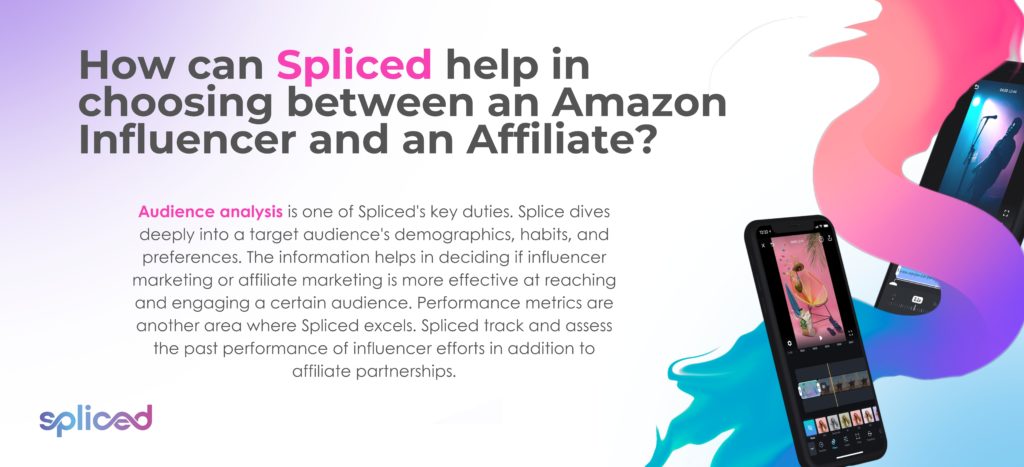
How can Spliced help in choosing between an Amazon Influencer and an Affiliate?
Spliced is a technology-driven platform that specializes in influencer and affiliate marketing, providing tools and data to help organizations and people make educated marketing decisions. Spliced offers assistance in today’s digital economy, where choosing between collaborating with Amazon Influencers or Amazon Affiliates has an impact on the success of a marketing campaign.
Influencer profile analysis is one of Spliced’s key duties. Splice dives deeply into a target audience’s demographics, habits, and preferences. The information helps in deciding if influencer marketing or affiliate marketing is more effective at reaching and engaging a certain audience. Spliced assists users in acquiring full insight into their clients by applying data analytics.
Performance metrics are another area where Spliced excels. Spliced track and assess the past performance of influencer efforts in addition to affiliate partnerships. The effectiveness of key performance indicators such as engagement rates, conversion rates, and return on investment is evaluated. The data-driven method helps users to make decisions based on historical performance, assisting them in selecting the strategy that has historically been more effective in achieving their goals.
Spliced provides a cost-benefit analysis, comparing the costs of influencer marketing versus affiliate marketing. Spliced includes influencer payments, content development costs, promotional charges, and on the other, affiliate commissions and advertising expenses. Spliced assists in determining which strategy provides the best return on investment by quantifying the financial factors.
Spliced gives information on how competitors use Amazon Influencers and Affiliates. Understanding how others in the same sector or specialty are implementing the methods is valuable. The data helps users differentiate themselves and make strategic decisions in a crowded environment.
Content and strategy recommendations are provided by Spliced’s team of experts. Spliced makes recommendations on the type of content that is expected to resonate with a specific target audience based on its assessments. It advises users on how to approach relationships with influencers or affiliates, ensuring that the strategy chosen is aligned with their aims and connects with their target audience.
Spliced helps users test influencer and affiliate marketing strategies through easy-to-setup campaigns, which helps users fine-tune their decision-making process. The method enables organizations and people to obtain real-world evidence on the effectiveness of each plan before making a final decision. It reduces the dangers associated with making decisions exclusively on theory.
Spliced forecast the ROI for influencer and affiliate marketing initiatives. Spliced helps customers to make well-informed decisions that maximize the efficacy of their marketing initiatives by offering insights into the long-term advantages and predicted outcomes.
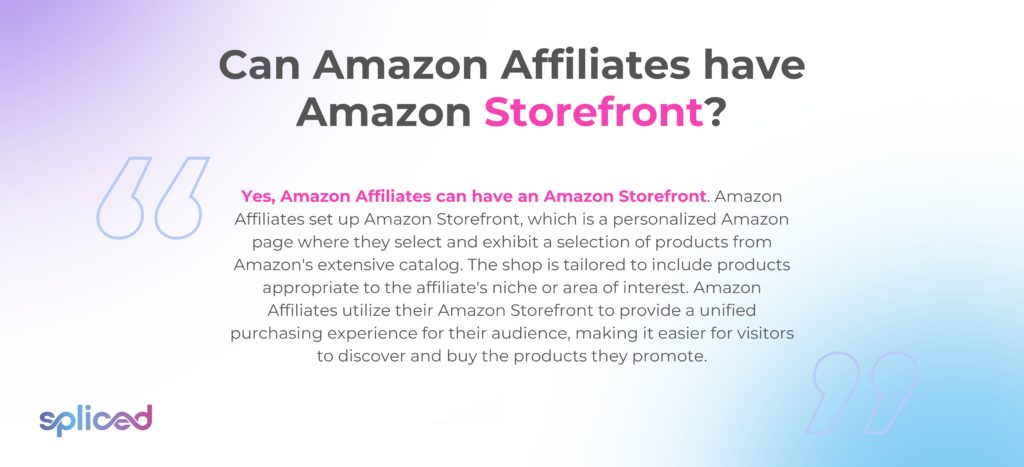
Can Amazon Affiliates have Amazon Storefront?
Yes, Amazon Affiliates can have an Amazon Storefront. Amazon Affiliates set up Amazon Storefront, which is a personalized Amazon page where they select and exhibit a selection of products from Amazon’s extensive catalog. The shop is tailored to include products appropriate to the affiliate’s niche or area of interest. Amazon Affiliates utilize their Amazon Storefront to provide a unified purchasing experience for their audience, making it easier for visitors to discover and buy the products they promote. The feature improves the affiliate’s capacity to efficiently push products to their target audience while earning commissions on sales generated by their curated storefront.
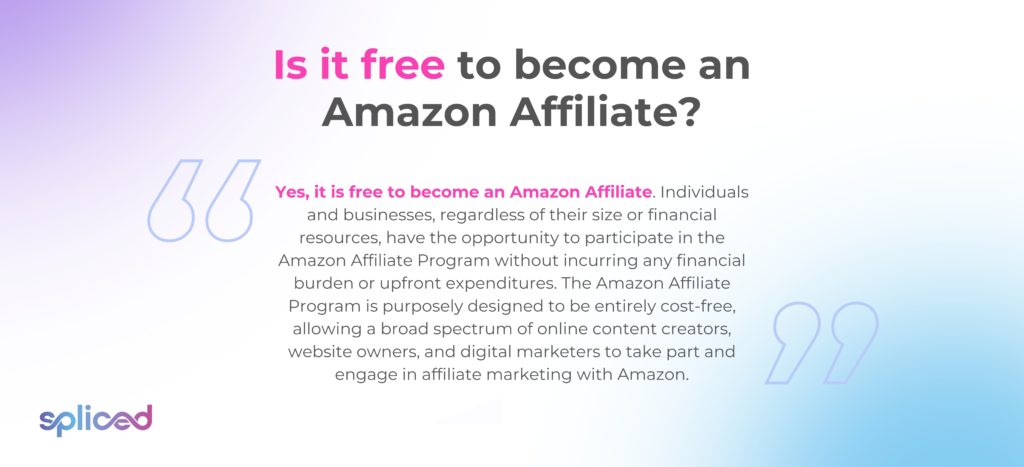
Is it free to become an Amazon Affiliate?
Yes, it is free to become an Amazon Affiliate. Individuals and businesses, regardless of their size or financial resources, have the opportunity to participate in the Amazon Affiliate Program without incurring any financial burden or upfront expenditures. The Amazon Affiliate Program is purposely designed to be entirely cost-free, allowing a broad spectrum of online content creators, website owners, and digital marketers to take part and engage in affiliate marketing with Amazon.
The open-access model allows a diverse community of participants to promote Amazon’s extensive range of products and services, all while earning commissions on qualifying transactions. The philosophy behind the Amazon Affiliate Program is to mutually benefit the Amazon affiliates and Amazon itself. Affiliates have the opportunity to leverage their online presence and expertise to generate income, without the need for substantial financial investment.
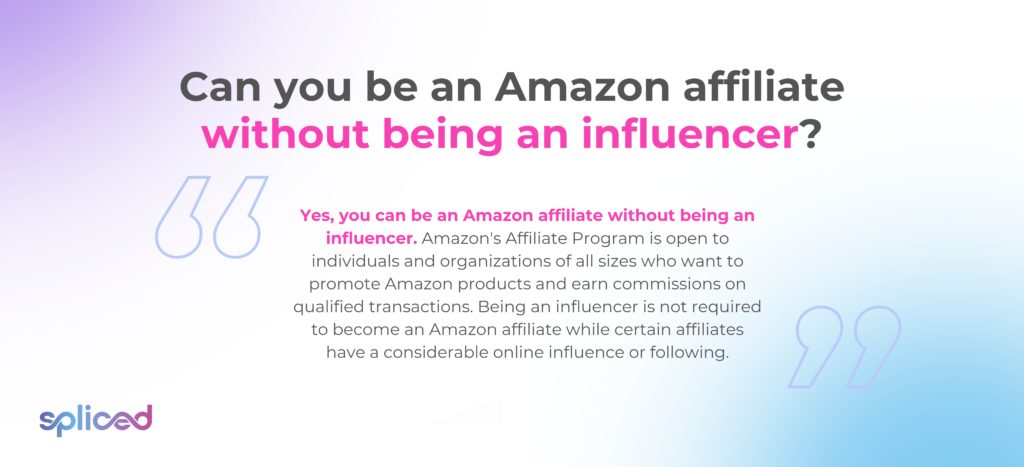
Can you be an Amazon affiliate without being an influencer?
Yes, you can be an Amazon affiliate without being an influencer. Amazon’s Affiliate Program is open to individuals and organizations of all sizes who want to promote Amazon products and earn commissions on qualified transactions. Being an influencer is not required to become an Amazon affiliate while certain affiliates have a considerable online influence or following. Amazon Affiliates run websites, blogs, YouTube channels, or other online platforms where they develop content and share useful information with their audience. Their concentration is on generating traffic to Amazon’s product pages and collecting commissions regardless of whether they have traditional influencer status or not. The openness allows a varied range of affiliates with varying content styles and online presences to engage in the program.
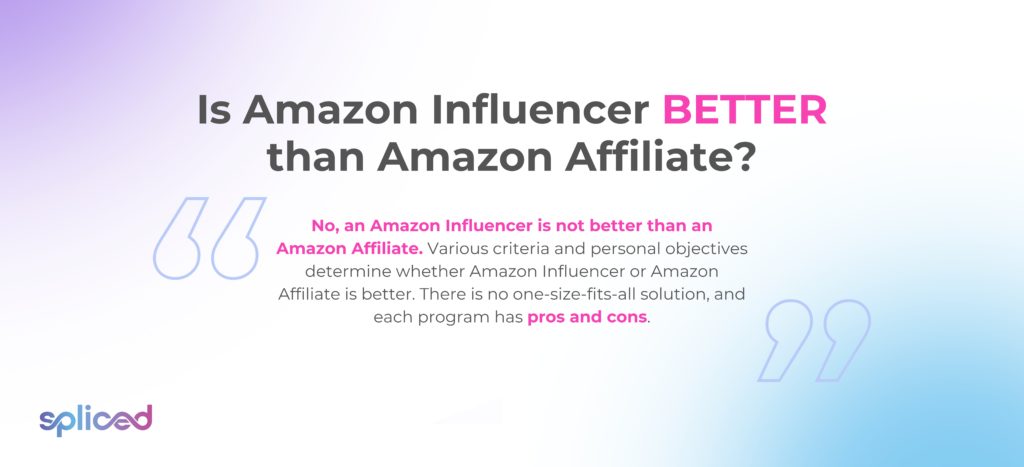
Is Amazon Influencer Better than Amazon Affiliate?
No, an Amazon Influencer is not better than an Amazon Affiliate. Various criteria and personal objectives determine whether Amazon Influencer or Amazon Affiliate is better. There is no one-size-fits-all solution, and each program has pros and cons.
Amazon Influencers are content providers who concentrate on developing a strong online image and engaging with their audience via social media channels. Amazon Influencers highlight trust, personal branding, and audience participation. Influencers are skilled at inspiring their followers and establishing genuine connections. A smart option if the objective is to develop a devoted and active following, particularly for lifestyle or product discovery material, is to become an Amazon Influencer.
Amazon Affiliates are focused on increasing sales and conversions. Amazon Affiliates operate through multiple online channels such as websites, blogs, and videos, attracting attention and directing it to Amazon product pages through SEO and other marketing methods. Acquiring an Amazon Affiliate account is a better option if the main goal is to make money through commissions from sales and if the person has a blog or website that specializes in reviews and suggestions of products.
The objectives influence the decision between an Amazon Influencer and an Amazon Affiliate, the type of content, and the target audience. The combination of the two programs proves beneficial for certain individuals or corporations. Evaluate specific conditions and select which program best corresponds with marketing objectives and the target audience’s needs.
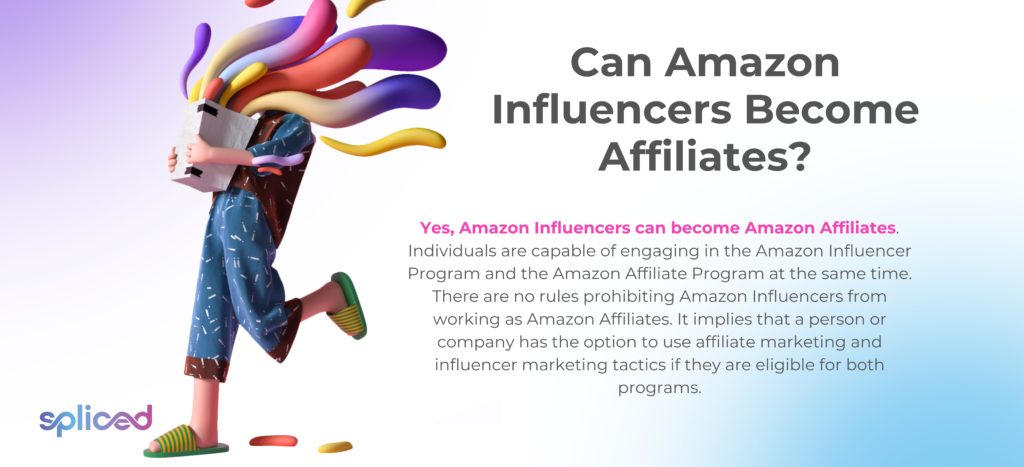
Can Amazon Influencers Become Affiliates?
Yes, Amazon Influencers can become Amazon Affiliates. Individuals are capable of engaging in the Amazon Influencer Program and the Amazon Affiliate Program at the same time. There are no rules prohibiting Amazon Influencers from working as Amazon Affiliates. It implies that a person or company has the option to use affiliate marketing and influencer marketing tactics if they are eligible for both programs. Combining programs creates options for diversifying income streams and reaching a larger audience by leveraging alternative marketing tactics.
